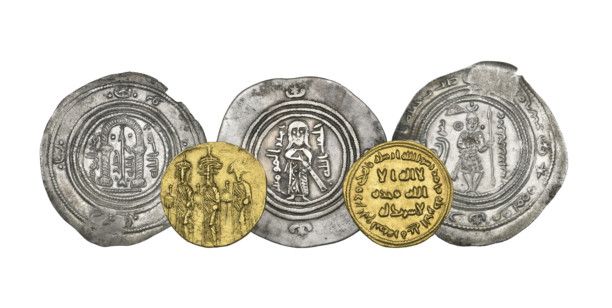
Dubai: As a UAE exhibition - Coins of Islam: History Revealed - with a display of 300 coins is proving to be a big draw at the Sheikh Zayed Grand Mosque Centre in Abu Dhabi, five rare coins are making big news globally because they offer a historic narrative of Islamic coinage, dating back to the 7th century or the dawn of Hijri (Islamic calendar).
Collectively the five coins – two gold and three silver – will be auctioned in London on April 2 and are estimated to fetch around £700,000 (Dh3.5 million), according to Morton & Eden, the only numismatic auctioneer in the world which currently holds regular auctions devoted xclusively to coins of the Islamic world.
Stephen Lloyd, Morton & Eden’s Islamic coin specialist, explained: “These highly sought-after rare coins tell the story of the first decades of Islam in a unique way. They show how the Islamic empire expanded both eastwards and westwards in the 7th century and how the conquered lands were unified through Islamic rule and culture.”
He added the coins that circulated during the early years of Islam provided additional cohesion to the society.
“In the early years of the great Muslim conquests there was no existing tradition of coinage so the rulers simply adapted or took inspiration from what coinage was in use for their own purposes,” Lloyd noted.
“However, after three decades of varying forms of hybrid coins, in 77 Hijra the first Umayyad gold dinar was struck, heralding the birth of a new purely Islamic coinage,” he explained.
Noting the importance of the rare coins in Islamic history, Lloyd said they are expecting the prices to even go up.
“The current market for Islamic coins of great rarity, such as these, is extremely buoyant as proved by the outstanding record price of £3.72million paid for an Islamic gold coin from the ‘Mine of the Commander of the Faithful in the Hijaz’, which we sold in our Islamic coin auction in October last year,” Lloyd shared.
The rare Umayyad gold dinar still remains the most expensive coin ever sold in a European auction.
Lot 1 - A gold solidus, possibly minted in the year 60 Hijri
(Estimated value: £60,000 - £80,000)
Gold coins were issued by Muslims who captured large parts of the Byzantine Empire, including Syria, Jordan, Lebanon and Egypt. “People living in these provinces used gold coins for centuries and the victorious Muslims showed little inclination to make significant changes in the coinage system. They used the existing Byzantine prototypes but removed any overt Christian symbolism – such as the cross,” said Lloyd.
The ‘modified cross’ solidi is one of the first ever gold coins struck by the Muslims, its type served as the genesis and precursor for the reformed, epigraphic, ‘purely Islamic’ gold coinage which came after.
Lot 2 - Arab-Sasanian ‘Standing Caliph’ silver
The reverse shows a standing figure of the Caliph with sword in hand presenting a striking expression of the power of Islam, although there are clear similarities in imagery between contemporary extant depictions of the Byzantine Emperor. The Muslim conquests had united lands from the Byzantines in the West with the former Sasanian Empire in the East – both areas already had their own distinct, very different coinage. This especially rare coin was in all likelihood struck at Damascus during the reign of Caliph Abd al-Malik in approximately 75 Hijri.
Lot 3- Arab-Sasanian ‘Mihrab and ‘Anaza’ drachm
(Estimated value £100,000 - £120,000).
Likely dating back to around 75 Hijri and said to have been struck in Damascus. The obverse depicts an armoured bust and a sheathed sword held in right hand. The inscription written in Pahlawi states the bust is the Sasanian ruler Khusraw. The reverse shows an arch supported on a columns (mihrab) in the centre of which is a spear staff, which has since been identified as the ‘anaza’ of Prophet Mohammed’s (PBUH). Scholars hailed the coin as the earliest depiction of this important Islamic architectural feature. They also suggested the coin might have played a part in the so-called war of images between the Muslims and Christians
Lot 4 - Military icon silver drachm
(Estimated value: £120,000 - £150,000).
One of the very last Arab-Sasanian drachms to be issued, the coin was struck at Anbir in 84 Hijri during the caliphate of Yazid B. Al-Muhallab. The obverse shows a Sasanian bust wearing a helmet as opposed to the more usual crown. The reverse, however, shows an even more pronounced departure from previous prototypes as it depicts a threatening warrior. The soldier wears chain mail armour and is armed with both a sword and spear. While the warrior is not explicitly identified; he maybe the Caliph or perhaps an idealised depiction of a Muslim fighter. The coin is considered as a highly symbolic token of Muslim military superiority. From an historical perspective, it also provides an accurate and naturalistic impression of the weapons and equipment of the first century of the Hijri.
Lot 5 - Gold dinar from 77 Hijri
(Estimated value: £180,000 – £220,000).
This was the first year when a purely Islamic coinage was struck. Expert Stephen Lloyd explains: “Abd al-Malik b Marwan’s introduction of a single, unified and distinctive Islamic gold coinage has rightly been seen as a landmark in the early history of Islam. The gold dinar is beautiful in its striking simplicity and is obviously and uncompromisingly Islamic.” The new Islamic coinage made a clean break with everything that had been used before. Gone were the modified crosses and imperial figural images of the Byzantine and Sasanian Empires, the new gold dinars were purely epigraphic in design, bearing quotations from the Qur’an. This dinar became the basis of a stable gold coinage produced in accordance with the Qur’anic precepts.
Do you want to see priceless coins?
With over 300 coins on display, the Coins of Islam: History Revealed exhibition boasts one of the world’s most significant collections of Arab and Islamic coins used across the Mediterranean, Western and Central Asia, and that continued to circulate during the early years of Islam. The exhibition at Shaikh Zayed Grand Mosque Centre in Abu Dhabi will run till April 28.












